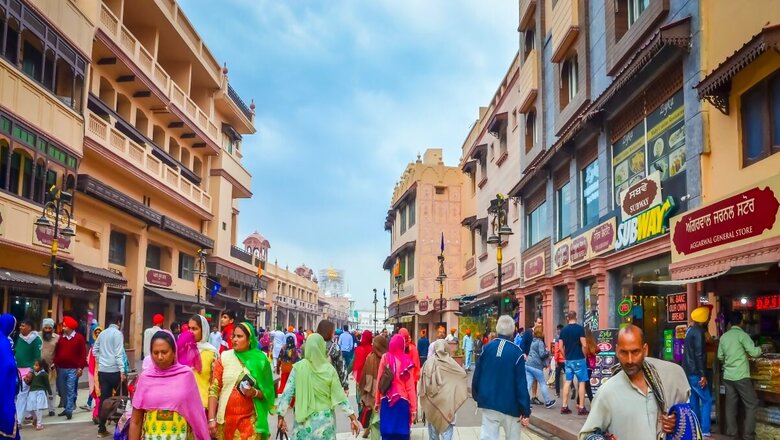
views
The Press In India 2021-22, the annual statement released by the Registrar of Newspaper for India (Ministry of I&B), provides an interesting insight into the print media scenario in Punjab. There are 28 Hindi dailies published in the state of Punjab that command a combined daily average circulation of 14,45,939, thus dwarfing the combined daily average circulation of 43 Punjabi newspapers (in Gurumukhi script) at 10,53,605. The situation alters slightly over a longer period, as the combined average circulation of all Hindi news periodicals (85) whether daily, weekly, fortnightly, monthly or quarterly in Punjab i.e. 16,45,878 is placed slightly below than that of Punjabi periodicals (130) at 16,64,670. This, however, leaves the main narrative of this article completely unaffected.
A random search on some newspaper portals throws up interesting evidence. Punjab Kesari, Punjab’s leading Hindi daily, brings out 17 editions from the frontier state, besides having penetration in several other neighbouring states. Dainik Bhaskar, the Madhya Pradesh-based popular Hindi daily runs no less than 15 editions in Punjab. Dainik Jagran, Northern India’s most popular Hindi daily, brings out 18 editions from Punjab.
The crux of the matter is that print media circulation figures indicate a strong presence of Hindi in Punjab. This might come as a complete surprise when one peruses the Census, 2011 figures pertaining to languages spoken in Punjab. Therein, only 25.94 lakh persons returned Hindi as their mother tongue as against 2.49 crore people who returned Punjabi. All notifications of the Punjab government, in addition to English, are in Gurumukhi, with the total exclusion of Hindi. Readers across India generally tend to subscribe to newspapers/magazines in their mother tongue and/or in English. English does not appear to be a factor in Punjab as the average circulation of news dailies and periodicals in that language is way below their Punjabi and Hindi counterparts. The question, therefore, is who reads Hindi newspapers/periodicals in Punjab? Admittedly, the readership of Hindi newspapers in Punjab is sustained by its substantial Hindu population (38.49 percent), overwhelmingly concentrated in the cities and therefore, has better literacy. Seen in this perspective, the exclusion of Hindi from the state apparatus of Punjab is not merely a language issue but also a communal one. Derecognising Hindi in Punjab after the reorganisation of the state in 1966 was a ploy to marginalise the Hindus. This was particularly atrocious as Hindus have been at the forefront of making the modern Punjab in the 19th century.
In colonial Punjab, a Muslim-majority province, Urdu was the predominant language used by Muslims, Hindus and Sikhs alike. For instance, the famous novelist Rajinder Singh Bedi (1915-1984), though a Sikh, originally wrote in Urdu. The same is true with noted lyricist Gulzar (Sampoorn Singh Kalra), who was born in a Sikh family. In Punjab (Pakistan), Urdu still remains the medium of instruction as in the rest of the Islamic Republic. Though Punjabis constitute half the population of Pakistan, Punjabi (written in Shahmukhi script) remains a neglected language. As a famous Urdu poet once said, “When a Punjabi speaks Urdu, it appears as if he is telling a lie.” Still, a number of illustrious Urdu poets like Faiz Ahmed Khan, Ibn-e-Insha, Munir Niazi and Amjad Islam Amjad etc, not to speak of 18th century Waris Shah, have been Punjabis. Similarly, in India, Abdul Hayee (1921-1980), better known as Sahir Ludhianvi, was an Urdu poet and lyricist though being a Punjabi.
The Sikhs were original custodians of the Punjabi language, who wanted to free themselves from the trappings of Urdu and Hindi. However, initial attempts to have Gurumukhi medium schools in colonial Punjab were damp squib. The Report on Public Instruction in Punjab and its Dependencies for the Year 1891-92 (vide Para No.100) says that the introduction of Punjabi language schools has found no success at all, even in places abounding in Sikh population, and ironically found few takers in Ferozepur district from where this idea germinated in 1889. In 1923, revolutionary Bhagat Singh received a prize of Rs 50/- in an essay competition organised by Punjab Hindi Sahitya Sammelan for his entry viz. Problem of Punjab’s Language and Script. Therein, he observes that Punjabi could not become a literary language of central Punjab (where Sikhs had substantial population). It was neither widely prevalent, nor had any literary or scientific significance. Bhagat Singh was particularly disturbed by Gurumukhi’s inability to write compound letters, even the word ‘poorna’ (complete) could not be written. Bhagat Singh asked how much would one benefit by adopting Gurumukhi, when it was known that it was a distorted form of Hindi script, and all rules are the same from beginning to end.
The Partition of India entailed the division of colonial Punjab, as a result of which, 16 out of its 29 districts were lost to Pakistan, and the rest (13) fell on the Indian side. The Sikh proposal for a sovereign state “Khalistan” (a term coined in the 1940s), was found unrealistic as the Sikhs formed a majority in none of the districts of colonial Punjab. The whole of Jullunder and Ambala divisions and the Amritsar district of Lahore division as well as three tehsils of Gurdaspur district viz. Pathankot, Gurdaspur and Batala were awarded to East Punjab as a result of the Radcliffe Award. Emotionally and materially, the Sikhs were affected by the partition more than the Hindus. They lost the cradle of Sikhism viz. Nankana Sahib, as well as the canal colonies of Lyallpur, Montgomery and Sargodha districts which they had developed by labour of one generation. However, on the plus side, with Muslims out of the picture, the clout of the Sikhs increased on the whole in the Eastern Punjab. Due to the resettlement pattern, Sikhs (mostly farmers), and Hindus (mostly urbane) were resettled into different parts of East Punjab. Following the merger of PEPSU, i.e. Phulkian states into East Punjab in 1955, the Sikh demographic appreciated in the resultant Punjab. As per the 1961 Census, it stood at 34 percent, whereas in colonial Punjab, it had merely been 13 percent.
Religion was not the only marker in Punjab but also language. In the Southern districts (which now constitute Haryana), and Northeastern districts (Himachal Pradesh), Hindi was the reigning language. The Akali Dal (established 1920) wanted a Sikh majority state in Punjab, a demand which it clothed in a linguistic garb called “Punjabi Suba”. In 1951-1952, Akalis (who had merged into the Congress in 1948 following the assassination of Mahatma Gandhi) resuscitated itself as a party and fought the first general elections on the plank of Punjabi Suba on the slogan that religion and politics are one. However, winning 14 seats out of 154 in the Punjab Legislative Assembly came as a setback. In 1954, it again launched a campaign for Punjabi Suba but withdrew it after the Centre devised a ‘regional formula’ dividing Punjab into two zones- Punjabi-speaking areas and Hindi-speaking areas.
While the Sikh leadership alleges anti-Sikh bias of the Centre for not granting the Punjabi Suba, the Report of the States Reorganization Committee (1955), chaired by Justice S. Fazl Ali (Retd.), advanced a nuanced recommendation against conceding the same. While the report antedated the ‘regional formula’, its recommendations were based on the areas claimed by Akali Dal in a memorandum for Punjabi Suba. The SRC Report cited that a sizable number of people residing in those territories were not in favour of any reorganisation of the province. The report displays great insight. The Hindus as a whole, it is argued, have never accepted Punjabi as their medium of expression, to the exclusion of Hindi, because while at home they speak the Punjabi language, in their religious ceremonies and festivals, in their schools and colleges, they use Hindi. In any case, they have never accepted the Gurmukhi script (P.142)
This is a truism that continues to be valid close to six decades after reorganisation of Punjab in 1966. The linguistic debate in rump Punjab was closed in favour of Punjabi in Gurumukhi script after Haryana and Himachal Pradesh, the two Hindu-dominated and Hindi-speaking states were carved out from Punjab. The high circulation of Hindi newspapers/periodicals is proof that Hindus have not given up Hindi. While Sikh political opinion would like to brand it as seditious, their allegation is actually an attempt to negate the contribution of Hindu Punjabis in the making of modern Punjab.
I took recourse to the book Punjab’s Eminent Hindus (1943) edited by N.B. Sen and published by New Book Society, Lahore, which sketched the lives of 20 Hindu ministers, judges, politicians, educationists and legislators. In them, I came across the activities of Goswami Ganesh Dutt, Swami Shraddhanand (Munsi Ram Vij), and Barrister Mukand Lal Puri who were Punjabi Hindus and also worked to advance Hindi in Punjab. It was mostly the Hindus of colonial Punjab who were at the forefront, making it a modern province.
Hindi comes naturally to Punjabi Hindus. Their strong presence in Bollywood from the days of Prithviraj Kapoor to Arjun Kapoor bears it out. The real test of a language is in original writing. From Mohan Rakesh (Madan Mohan Guglani) to Narendra Kohli, many Punjabi Hindus have excelled in Hindi literature. A number of lyricists in Bollywood like D.N. Madhok, Kidar Sharma, Rajendra Krishan, Anand Bakshi, and Gulshan Kumar Mehta (nickname “Bawra”) were from Punjab. Hindi is as much a natural language for the Punjabi Hindus as is Punjabi. Devendra Kumar Bahl, from Patiala, at the age of 70 years started a new Hindi literary magazine in New Delhi viz. Abhinav Imroz to identify and promote new literary talents. The magazine has become popular amongst lovers of Hindi literature in India.
The Hind newspapers in Punjab are tailor-made to appeal to the Hindus, not the Sikhs. For instance, on April 3, 2023 Dainik Bhaskar (Amritsar Edition) carried out an exclusive report by Rohit Sharma from Washington about how Hinduism is advancing across the USA, and within two decades the number of Hindu temples has increased from 435 to 1000. Uttam Hindu (Punjab-Chandigarh) on April 4, 2023 gave front-page publicity to Punjab CM Bhagwant Mann’s statement that a Yoga centre would be a boon to all Punjabis.
There was a fiery debate in the 1950s and 60s regarding the mother tongue of Punjabi Hindus. Professor Om Prakash Kahol, himself an Arya Samajist, and member of Hindu Mahasabha, based in Hariana (Hoshiarpur dist) in 1955 argued that the language of Hindus of Punjab was Punjabi in Gurumukhi script. His book The Hindus of Punjabi State (1955), published by Hindu Prachar Sabha, Ambala Cantonment, had a deeply religious hue wherein he tried to emphasise the history of indissoluble Hindu-Sikh bonds and the common fight against Islam. Such apparently nationalist arguments have often been overlooked. The reality is that Hindus have no interest in Sikh politics and their tastes are at par with other Hindus of India. Hindus of Punjab are not against Punjabi, but they would not like to abandon Hindi either.
It is clear in hindsight that Hindus of Punjab have retained Hindi, despite the purblind language policy of the Punjab government. No sense of guilt should attach to it. The “either/or” trap between Punjabi and Hindi, into which the Sikh opinion tried to nudge Punjab, will not work for the Hindus. While Punjabi Hindus might speak Punjabi with felicity, they are comfortable in reading and writing Hindi in Devanagari script.
The writer is author and independent researcher based in New Delhi. The views expressed herein are his personal.
Read all the Latest Opinions here



















Comments
0 comment